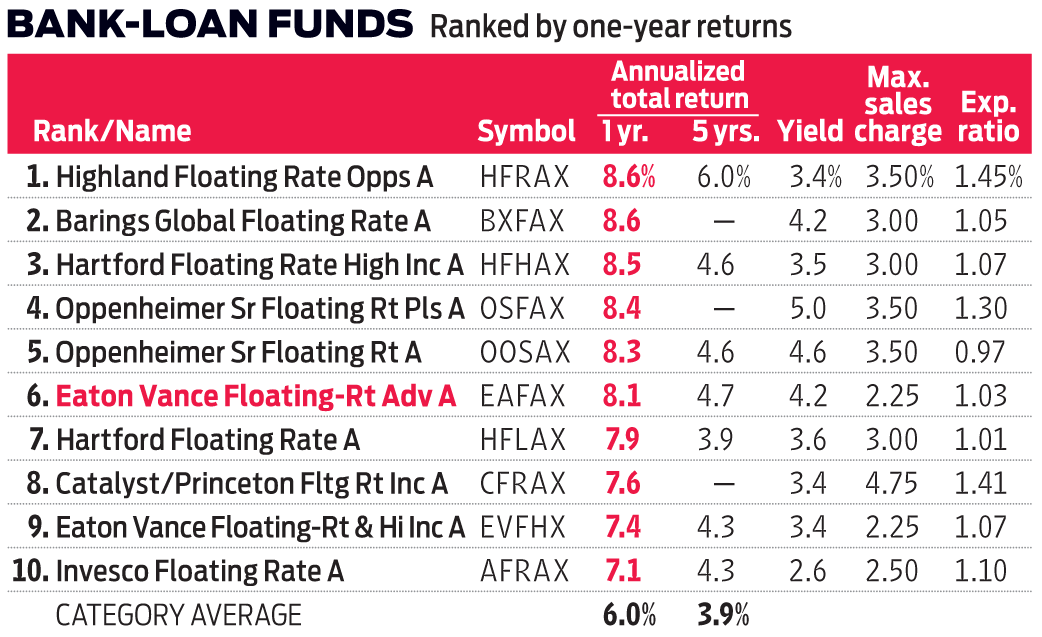This Fund Banks on Bank Loans
Eaton Vance Floating-Rate Advantage should thrive as interest rates rise.


For income seekers, rising interest rates often mean trouble. That’s because prices of bonds usually fall when rates climb. One way to defend against rising rates is to invest in floating-rate loans. Rates on these loans, which banks make to businesses, are pegged to short-term benchmarks and typically reset every 30 to 90 days. That means that when rates rise, the interest you receive on these IOUs, also called “leveraged loans,” goes up as well.
Because many investors expect rates to rise, they have been pouring money into bank loans. But these investments come with another kind of risk. Firms that take out floating-rate loans typically carry sub-investment-grade credit ratings and are more likely to default than less-indebted, higher-quality firms.
For most people, the best way to invest in bank loans is through a mutual fund, such as Eaton Vance Floating-Rate Advantage (symbol EAFAX), that avoids loans to high-risk borrowers. Managers Scott Page and Craig Russ, along with a team of 29 researchers, start by weeding out the smallest borrowers as well as companies that have too much debt. The team favors loans issued to established companies with ample earnings and assets to cover their debts. To be considered for inclusion in the portfolio, a loan must be “senior secured,” meaning that in the case of a default, holders of the loan have first dibs on the company’s assets—even before bondholders.

Sign up for Kiplinger’s Free E-Newsletters
Profit and prosper with the best of expert advice on investing, taxes, retirement, personal finance and more - straight to your e-mail.
Profit and prosper with the best of expert advice - straight to your e-mail.
Nearly all of the fund’s holdings carry below-investment-grade ratings, but the managers skew toward better-quality junk. At last report, the fund had 86% of its assets in double-B and single-B-rated loans (the highest junk ratings), compared with 69% for the average bank-loan mutual fund. Those loans the managers deem the least risky occupy the largest positions in the portfolio, but no loan commands more than 1% of assets. The strategy, the managers say, is to win more by losing less.
Of course, they are still trying to win. To juice up the fund’s yield, the managers borrow the equivalent of 20% to 30% of its assets and use the proceeds to invest in additional bank loans. The fund’s Class A shares currently yield an above-average 4.2%. They come with a 2.25% sales charge, but are available without a load or transaction fee at several online brokers.

Get Kiplinger Today newsletter — free
Profit and prosper with the best of Kiplinger's advice on investing, taxes, retirement, personal finance and much more. Delivered daily. Enter your email in the box and click Sign Me Up.

Ryan joined Kiplinger in the fall of 2013. He wrote and fact-checked stories that appeared in Kiplinger's Personal Finance magazine and on Kiplinger.com. He previously interned for the CBS Evening News investigative team and worked as a copy editor and features columnist at the GW Hatchet. He holds a BA in English and creative writing from George Washington University.
-
 Designing Your 'Immortal' Financial Plan
Designing Your 'Immortal' Financial PlanExplore an approach that offers solutions for those navigating the intersection of longevity, fulfillment and financial security.
By Dennis McNamara
-
 How to Protect Your Privacy While Using AI
How to Protect Your Privacy While Using AIHow to keep your information and finances safe while using AI, including ChatGPT and Perplexity.
By Bob Haegele
-
 Dividends Are in a Rut
Dividends Are in a RutDividends may be going through a rough patch, but income investors should exercise patience.
By Jeffrey R. Kosnett
-
 Municipal Bonds Stand Firm
Municipal Bonds Stand FirmIf you have the cash to invest, municipal bonds are a worthy alternative to CDs or Treasuries – even as they stare down credit-market Armageddon.
By Jeffrey R. Kosnett
-
 High Yields From High-Rate Lenders
High Yields From High-Rate LendersInvestors seeking out high yields can find them in high-rate lenders, non-bank lenders and a few financial REITs.
By Jeffrey R. Kosnett
-
 Time to Consider Foreign Bonds
Time to Consider Foreign BondsIn 2023, foreign bonds deserve a place on the fringes of a total-return-oriented fixed-income portfolio.
By Jeffrey R. Kosnett
-
 The 5 Best Actively Managed Fidelity Funds to Buy Now
The 5 Best Actively Managed Fidelity Funds to Buy Nowmutual funds In a stock picker's market, it's sometimes best to leave the driving to the pros. These Fidelity funds provide investors solid active management at low costs.
By Kent Thune
-
 The 5 Safest Vanguard Funds to Own in a Volatile Market
The 5 Safest Vanguard Funds to Own in a Volatile Marketrecession The safest Vanguard funds can help prepare investors for continued market tumult, but without high fees.
By Kyle Woodley
-
 The 12 Best Bear Market ETFs to Buy Now
The 12 Best Bear Market ETFs to Buy NowETFs Investors who are fearful about the more uncertainty in the new year can find plenty of protection among these bear market ETFs.
By Kyle Woodley
-
 5 of the Best Preferred Stock ETFs for High and Stable Dividends
5 of the Best Preferred Stock ETFs for High and Stable DividendsETFs The best preferred stock ETFs allow you to reduce your risk by investing in baskets of preferred stocks.
By Kyle Woodley